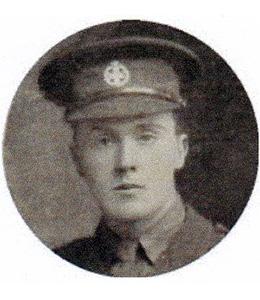Killed in action aged 23
Buried in Sanctuary Wood British Military Cemetery, Zillebeke near Ypres.
Gilbert Walbert Lyttelton was born in Leeds, the fifth and youngest child of Edward Stuart Talbot, the Vicar of Leeds Parish Church (later Bishop of Winchester) and Lavinia Lyttleton, daughter of George 4th Baron Lyttleton and Mary Glyne.
As a child he was noted for “his love of fun and nonsense, and love of beauty“. When his older brother Neville, fought in the South African War the eight year old Gilbert was fascinated by it. “He could have stood a cross examination in all the battles, small or big, and in the generals and heroes on the Natal side of the fighting“.
In September 1905 Gilbert went to Winchester to the house of Mr Bramston (known to all Wykehamists as “Trant”). After some early troubles to which, perhaps, a certain lack of discipline contributed, he became one of the most devoted Wykehamists, passionately enthusiastic over the school and his years there. “Every minute is precious and every stone a jewel,” he says of his last days at school.
In October 1910 Gilbert went up to Christ Church and soon became a member of the Union where he was successively elected Secretary, Treasurer and President, following a good family tradition, his grandfather, father, and eldest brother all preceding him.
Gilbert commenced Service August 1914, at an officer’s training camp at Churn alongside countless university and public school men. “A month’s most strenuous training was got through in beautiful weather, with a considerable amount of enjoyment and zest in most congenial company. Gilbert shared a tent with Mr Kay-Shuttleworth, and they were devoted to their Colonel, Colonel Maclachlan, afterwards Colonel of the 8th Battalion of the Rifle Brigades. The friends were given commissions in the 7th Battalion Rifle Brigade (Prince Consort‘s Own).
“It was the deep and earnest conviction in the righteousness of the cause for which England joined the War, that made Gilbert a keen soldier, and this conviction grew and deepened as the months went by. He did not wish any more than before the outbreak of War to take up soldiering as a profession, but he did become a most keen, efficient and strict officer, delighting in the learning of so much that was new and interesting, and especially in the responsibility of having the fifty-four men of his platoon under his direct control, and watching their development and excellent progress. The bottom of it all and of the kindling enthusiasm was the great cause of freedom for which the Allies were fighting.”
He was killed in action at Hooge. From Major H D Ross (2nd in Command 7th Battalion Rifle Brigade) “Gilbert died leading his men. No one could have done more. All the men of his company were very much attached to him, and when we heard in the middle of the action, he had been hit, several men at once volunteered to go and bring him in although the enemy‘s fire was still very heavy. Two lots started, but as the men in each were hit, the attempt had to be given up. To us he is a great loss, as he was always in good spirits and cheery, and had something amusing to say.” Gilbert‘s body could not be retrieved for a week, but was then laid to rest near where he fell. Later moved to the Sanctuary Wood cemetery.
(quotations from the privately published book ‘Gilbert Talbot’ by his mother)
The Story of Talbot House (TOC H).
On 11 December 1915 the house at number 43 Gasthuisstraat (at that time the street was called by its French name - Rue de l'Hopital) opened its doors for the first time, welcoming British soldiers to a new club. The house was named Talbot House in memory of Lieutenant Gilbert W L Talbot, aged 23, who was the brother of Padre Neville Talbot. Gilbert was serving with 7th Battalion of The Rifle Brigade when he was killed at Hooge in the Ypres Salient on 30 July 1915. His death came during a British counter-attack following the German Army's first use of liquid fire on the Western Front. Gilbert was the youngest son of the Lord Bishop Talbot of Winchester and left a career of brilliant promise unfulfilled. The name Talbot House soon became known to the soldiers of the Ypres Salient in a shortened form of "TOC H". TOC was the British Army signaller's code for 'T', and H was 'H'.
From “The Great War 1914-1918”

